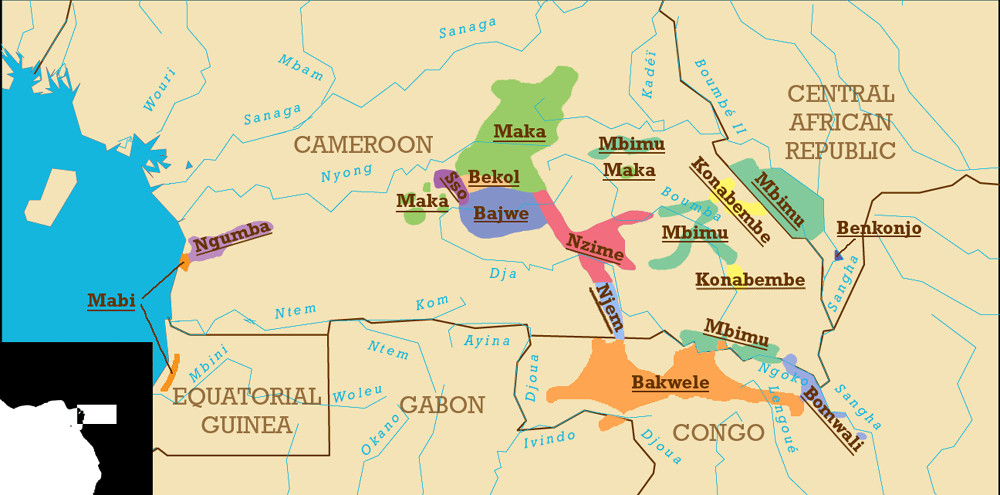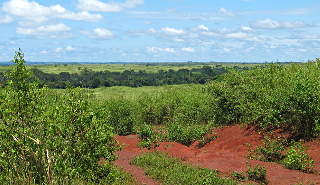|
Messaména
Messamena (also spelled Messaména) is a town and Communes of Cameroon, commune in Cameroon. Location The town of Messamena is the capital of the ''arrondissement'' (commune) of the same name. They are located in the Haut-Nyong, Haut-Nyong Department, East Region (Cameroon), East Region.Messamena , ''Communes et villes unies du Cameroun'' (2014) [based on Plan Communal de Developpement ' (Yaoundé: Centre de Reflexion et d'Action pour le Developpement Local, July 2012), pp. 15-25). The commune is bounded to the north by the commune of Atok, Cameroon, Atok (Maka-bebend), to the south by Somalomo, to the east b ... [...More Info...] [...Related Items...] OR: [Wikipedia] [Google] [Baidu] |
Somalomo
Somalomo is a town and Communes of Cameroon, commune in Cameroon. On October 5, 1992 President Biya of Cameroon signed the decree No. 92/206 officially creating 47 new administrative subdivisions and districts units in the country, consequently setting up new urban centres at the head towns of newly created District units. Somalomo, in the Eastern province then, Upper Nyong Division and Messaména Subdivision, was among these new administrative units and towns. From its 100 inhabitants at that time, Somalomo has now grown to more than 1000 people. It hosts a Sous-Prefecture, a police station (gendarmerie), an Education Office, a secondary school, a health centre, Wildlife Protection and Revenue Collection offices. Although official administrative buildings and housing for civil servants have not yet been completed, this new administrative unit offers and provides basic public services to at least 10,000 people. Before the Germans However, the history of that then sleepy and dus ... [...More Info...] [...Related Items...] OR: [Wikipedia] [Google] [Baidu] |
Badjoué
The Badwe'e (also ''Bajwe'e''; French ''Badjoué'') are an ethnic group inhabiting the rain forest zone of southeastern Cameroon. They recognize themselves as the descendants of Edwe'e, the youngest son of Koo and the brother of Njeme and Nzime. The Badwe'e live south of Messaména in the East Province in a region south of the Bekol and both north and west of the Nzime. Their territory includes much of the northern and western border of the Dja Biosphere Reserve. They speak a dialect of Koozime, together with the Nzime. History The ancestors of the Badwe'e lived in the Congo River basin or the present territory of Chad before moving into the present territory of Cameroon between the 14th and 17th centuries. Along with the other speakers of Makaa–Njyem languages, they lived along the northern Lom River near the present-day border between the Adamawa and East provinces. Under pressure from migrating Beti-Pahuin groups (themselves fleeing the Vute and Mbum), the Makaa–Nje ... [...More Info...] [...Related Items...] OR: [Wikipedia] [Google] [Baidu] |
East Region (Cameroon)
The East Region (french: Région de l'Est) occupies the southeastern portion of the Republic of Cameroon. It is bordered to the east by the Central African Republic, to the south by Congo, to the north by the Adamawa Region, and to the west by the Centre and South Regions. With 109,002 km2 of territory, it is the largest region in the nation as well as the most sparsely populated. Historically, the peoples of the East have been settled in Cameroonian territory for longer than any other of the country's many ethnic groups, the first inhabitants being the Baka (or Babinga) pygmies. The East Region has very little industry, its main commerce consisting of logging, timber, and mining. Instead, the bulk of its inhabitants are subsistence farmers. The region is thus of little political import and is often ignored by Cameroonian politicians. This coupled with the low level of development in the province have led to its being dubbed "the forgotten province". The southwest regi ... [...More Info...] [...Related Items...] OR: [Wikipedia] [Google] [Baidu] |
Communes Of Cameroon
The Arrondissements of Cameroon are the third-level units of administration in Cameroon. The arrondissements are organised by divisions and sub divisions of each province (now Regions). As of 2005 (and since 1996) there are 2 urban communities (Douala and Yaoundé) divided into 11 urban districts (5 in Douala and 6 in Yaounde), 9 towns with special status (Nkongsamba, Bafoussam, Bamenda, Limbe, Edéa, Ebolowa, Garoua, Maroua and Kumba Kumba is a metropolitan city in the Meme department, Southwest Region, Western Cameroon, referred as "K-town" in local slang. Kumba is the most developed and largest city in the Meme Department and has attracted people from the local villag ...), 11 urban communes and 305 rural communes. The councils are headed by mayors and municipal councillors who are elected. The councils have a responsibility in principle for the management of local affairs under the supervision of the State. Under Cameroonian law, the councils provide and re ... [...More Info...] [...Related Items...] OR: [Wikipedia] [Google] [Baidu] |
Djansang
''Ricinodendron'' is a plant genus in the family Euphorbiaceae first described as a genus in 1864. It includes only one known species, ''Ricinodendron heudelotii'', native to tropical Africa from Senegal + Liberia east to Sudan and Tanzania and south to Mozambique and Angola. It produces an economically important oilseed. The tree is known as munguella (Angola), njangsa (Cameroon), bofeko (Zaire), wama (Ghana), okhuen (Nigeria), kishongo (Uganda), akpi (Ivory Coast), djansang, essang, ezezang and njasang. Two varieties of the tree species are recognized ''R. heudelotii'' var. ''heudelotii'' in Ghana and ''R. heudelotii'' var. ''africanum'' in Nigeria and westwards. Taxonomy The mongongo fruit (''Schinziophyton rautanenii'') was previously considered a member of this genus but has since been placed into a genus of its own. ;Subspecies and varieties # ''Ricinodendron heudelotii'' subsp. ''africanum'' ( Müll.Arg.) J.Léonard - tropical Africa from Nigeria east to Sudan and Tanza ... [...More Info...] [...Related Items...] OR: [Wikipedia] [Google] [Baidu] |
Chromolaena Odorata
''Chromolaena odorata'' is a tropical and subtropical species of flowering shrub in the family Asteraceae. It is native to the Americas, from Florida and Texas in the United States south through Mexico and the Caribbean to South America. It has been introduced to tropical Asia, West Africa, and parts of Australia. Common names include Siam weed, Christmas bush, jack in the box, devil weed, Communist Pacha (കമ്മ്യൂണിസ്റ്റ് പച്ച) in Malayalam, common floss flower, rompe saragüey (in Spanish), Abani di egwu or Nsiibilibe (Igbo language), ewé Akíntọ́lá ( Yorùbá) and triffid.Lalith Gunasekera, ''Invasive Plants: A guide to the identification of the most invasive plants of Sri Lanka'', Colombo 2009, p. 116–117. Description ''Chromolaena odorata'' is a rapidly growing perennial herb. It is a multi-stemmed shrub which grows up to 2.5 m (100 inches) tall in open areas. It has soft stems but the base of the shrub is woody. In shady ar ... [...More Info...] [...Related Items...] OR: [Wikipedia] [Google] [Baidu] |
Bridelia Ferruginea
''Bridelia'' is a plant genus of the family Phyllanthaceae first described as a genus in 1806.Willdenow, Carl Ludwig von. 1806. Species Plantarum. Editio quarta 4(2): 978-979 in Latin It is widespread across , , southern , and various islands of the and |
Annona Senegalensis
''Annona senegalensis'', commonly known as African custard-apple, wild custard apple, wild soursop, (Mandinka language), and (Wolof language) is a species of flowering plant in the custard apple family, Annonaceae. The specific epithet, ''senegalensis'', translates to mean "of Senegal", the country where the type specimen was collected. A traditional food plant in Africa, the fruits of ''A. senegalensis'' have the potential to improve nutrition, boost food security, foster rural development and support sustainable land care. Well known where it grows naturally, it is largely unheard of elsewhere. Description ''Annona senegalensis'' takes the form of either a shrub or small tree, growing between two and six meters tall. Occasionally, it may become as tall as 11 m. *It has bark of smooth or coarse texture, that can be a gray-silver or gray-brown. It is leaf-scarred, with nearly round flaking, showing lighter-hued spaces of under bark. *Branches have thick, gray, brown or yel ... [...More Info...] [...Related Items...] OR: [Wikipedia] [Google] [Baidu] |
Nyong River
The Nyong (formerly german: Yong) is a river in Cameroon. The river flows approximately to empty into the Gulf of Guinea. Course The Nyong originates east of the town of Abong-Mbang, where the northern rain forest feeds it. The river's length is almost parallel to the lower reaches of the Sanaga River. Its mouth is in Petit Batanga, south-southwest of Edéa. In two places, Mbalmayo and Déhané, the river has huge rapids. The first of the river, between Abong-Mbang and Mbalmayo, are navigable for small boats from April to November. Hydrology The flow of the river as measured at Déhané in m³/s: Transport The town of Mbalmayo, which has a railhead, lies on the north bank of this river. The towns of Akonolinga Akonolinga is a town and commune situated in Cameroon's Centre Province, with a population of roughly 21,300. It lies on the Nyong River, due east of the capital Yaoundé Yaoundé (; , ) is the capital of Cameroon and, with a population of ... and Abo ... [...More Info...] [...Related Items...] OR: [Wikipedia] [Google] [Baidu] |
Bras Fleuve Nyong
A broadband remote access server (BRAS, B-RAS or BBRAS) routes traffic to and from broadband remote access devices such as digital subscriber line access multiplexers (DSLAM) on an Internet service provider's (ISP) network. BRAS can also be referred to as a broadband network gateway or border network gateway (BNG).{{cite web, title=TR-101 Migration to Ethernet-Based DSL Aggregation, url=https://www.broadband-forum.org/technical/download/TR-101_Issue-2.pdf, website=Broadband Forum, accessdate=12 April 2018 The BRAS sits at the edge of an ISP's core network, and aggregates user sessions from the access network. It is at the BRAS that an ISP can inject policy management and IP quality of service (QoS). The specific tasks include: * Aggregates the circuits from one or more link access devices such as DSLAMs * Provides layer 2 connectivity through either transparent bridging or PPP sessions over Ethernet or ATM sessions * Enforces QoS policies * Provides layer 3 connectivity and ... [...More Info...] [...Related Items...] OR: [Wikipedia] [Google] [Baidu] |
Bulu People
The Beti-Pahuin are a Bantu people, Bantu ethnic group located in rain forest regions of Cameroon, Republic of the Congo, Equatorial Guinea, Gabon, and São Tomé and Príncipe. Though they separate themselves into several individual clans, they all share a common origin, history and culture Estimated to be well over 8 million individuals in the early 21st century, they form the largest ethnic group in central Cameroon and its capital city of Yaoundé, in Gabon, and in Equatorial Guinea. Their Beti language, Beti languages are Mutual intelligibility, mutually intelligible. Group distinctions The Beti-Pahuin are made up of over 20 individual clans. Altogether, they inhabit a territory of forests and rolling hills that stretches from the Sanaga River in the north to Equatorial Guinea and the northern halves of Gabon to Congo to the south, and from the Atlantic Ocean to the west to the Dja River in the east. Beti The first grouping, called the Beti, consists of the Ewondo (more pr ... [...More Info...] [...Related Items...] OR: [Wikipedia] [Google] [Baidu] |
Hausa People
The Hausa ( autonyms for singular: Bahaushe ( m), Bahaushiya ( f); plural: Hausawa and general: Hausa; exonyms: Ausa; Ajami: ) are the largest native ethnic group in Africa. They speak the Hausa language, which is the second most spoken language after Arabic in the Afro-Asiatic language family. The Hausa are a diverse but culturally homogeneous people based primarily in the Sahelian and the sparse savanna areas of southern Niger and northern Nigeria respectively, numbering around 83 million people with significant indigenized populations in Benin, Cameroon, Ivory Coast, Chad, Sudan, Central African Republic, Republic of the Congo, Togo, Ghana, Eritrea, Equatorial Guinea, Gabon, Senegal and the Gambia. Predominantly Hausa-speaking communities are scattered throughout West Africa and on the traditional Hajj route north and east traversing the Sahara, with an especially large population in and around the town of Agadez. Other Hausa have also moved to large coastal cities in the re ... [...More Info...] [...Related Items...] OR: [Wikipedia] [Google] [Baidu] |





.jpg)